2 Principles and Process in Community Development
Dr. Mahbub Hasan MSW, Ph.D.
Topics:
- Principles in community Development
- Process in Community Development
- Case Study
Introduction
This chapter discusses principles and processes in community development. The goal of community development is to bring positive change in the people’s socio-economic, environmental, cultural, religious, and political lives. Community development is a process that brings people together to address social and community issues affecting them. Some examples of community initiatives are skill enhancement for better livelihood opportunities, infrastructure development such as roads, schools, and parks construction, quality of education and health services in a community, and addressing poverty, inequalities, racism, homophobia, and marginalization through community organizing and advocacy. Some may argue whether all community development works aims to address social issues such as poverty, inequality, and systemic issues. Some community development work may not directly focus on the problem/issue but instead maintain ongoing relationships and infrastructures.
While working in community development, I have had the opportunity to work with rural, urban, and Indigenous communities and various social groups in the developing countries in Asia and Canada. One thing I learned is that each community context and its issues and initiatives are unique. The success or failure of a community project/program depends on who identified community issues, how community issues are analyzed, who developed principles, frameworks and actions for community change and how the project/program is implemented.
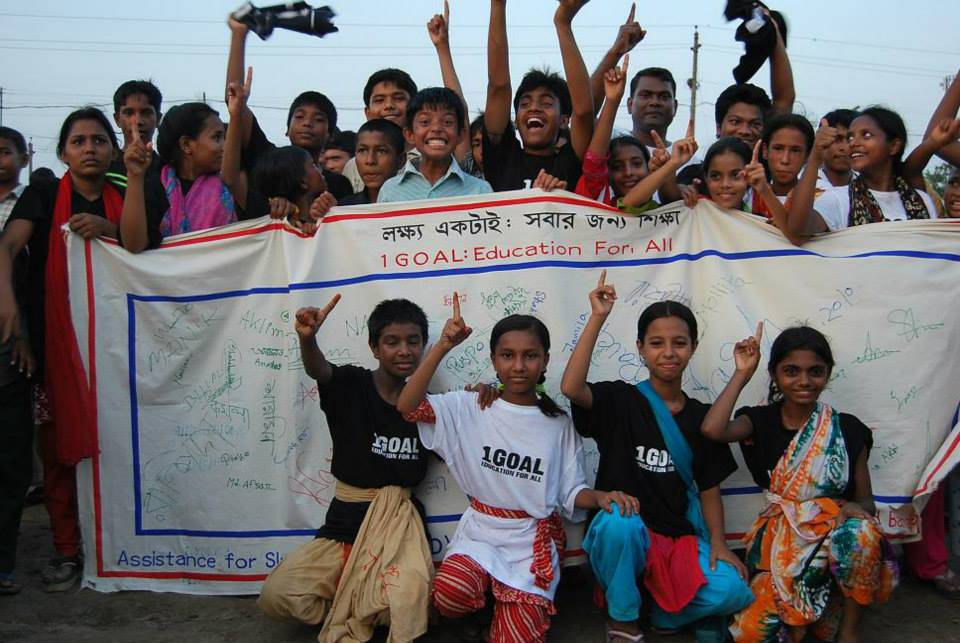
1. Principles in community Development
Promote Community Leadership and Ownership
The most important principle is, through the community development process, to actively working with the community to increase leadership capacity, skills, confidence, and aspirations.. Our work is to help community members understand the economic, social, political, environmental, and psychological impact of alternative solutions to the problem (Michigan State University). The community has the primary responsibility for decision-making (Parada et al., 2012). This decision-making includes issue identification, planning, implementation, and resource mobilization to solve agreed-upon problems by emphasizing shared leadership and active citizen participation. Therefore, the community members are primarily responsible for initiating community change work and should own it.
Secure Human Rights
The community initiative should focus on human rights principles. The community and practitioners must adopt the Universal Declaration of Human Rights in their work. The first three articles of the Universal Declaration of Human Rights states that “All human beings are born free and equal in dignity and rights”; “Everyone has the right to life, liberty, and security of person,” and “Everyone is entitled to all the rights and freedoms without distinction of any kind, such as race, colour, sex, language, religion, political or other opinion, national or social origin, property, birth or other status “. The Universal Declaration of Human Rights must shape our collective work with the community because this instrument allows community and Community Development workers to identify their challenges and barriers. This instrument (Universal Declaration of Human Rights) also provides community and Community Development workers provided legitimate/lawful grounds for addressing community issues, human development, and fighting against poverty, discrimination, and oppression. As a Community Development worker, you may practice various approaches such as the Human Rights-Based Approach, Anti Oppression Approach, and Anti-Racism Approach in community development work. One common thing in these approaches is that ‘people are at the heart of community development and workers collaborate with the community members to bring positive change’.
Enhance Quality of Living
The community development should focus on the well-being and quality of living. The initiative may focus on economic, physical, and/or social development. A multi-year initiative may focus on all these components. However, the community initiative is most successful when the community takes one step at a time.
Promote Social Justice
As transformative community workers, our work must be guided by social justice principles, especially equity and inclusion. Community workers work with the community and critically examine the root causes of poverty, marginalization, and exclusions. Therefore, community practitioners work with excluded community members and equip them with knowledge, skills, and resources for their empowerment.
Bottom-Up Approach: Community Participation and Engagement
Community workers continue to put their efforts into ensuring the active participation of community members in the community change process. Community group members who experience poverty, marginalization, violence, conflicts, or environmental disasters know their needs and what needs to be done. Community workers should engage community members in problem diagnosis so that those affected may adequately understand the causes of their situation (Michigan State University). Therefore, as community workers, we must strive to engage the community from ‘the bottom-up’ in every step of the project/program, from issue identification to project planning, implementation, and evaluation. The traditional top-down service delivery approach where community members are just recipients of services and not active participants, is disempowering and further marginalizes community members. Without a bottom-up approach, community initiatives may cause harm to people.
Community Assets / Capital and Resource Mobilization
Community development initiatives should build upon and focus on community assets / capital. Both terms ‘assets’ and ‘capital’ are used interchangeably, and mean the same thing, which are the strengths of the community. Asset-based CD (ABCD) is a term used to…Each community relies on different forms of capital to maintain itself and grow stronger (Parada et al., 2012). Capital includes environmental, physical, economic, human, information, political, and social resources in the community. A community needs all these forms of capital. Among these, social capital is most important in community development. We create social capital when we become involved with one another in routine, often organized ways (Parada et al., 2012). High levels of social capital in a community promote coordination, communication, participation, cooperation, and engagement; thus, positive change is possible (Parada et al., 2012). Rather than seeing communities as “needy” and problem-based, communities should be seen in terms of assets, skills, and capacities (Parada et al., 2012). Exploring, identifying, and mobilizing local capital are the key responsibilities of community workers for sustainable community development. Roseland (2012) argues that sustainable development of communities requires mobilizing citizens and their governments to strengthen all forms of community capital.
Partnership and Collaboration
Community issues and problems are complex. These issues may arise due to individual, cultural and systemic oppression, colonialism, neoliberal policies, patriarchal system, and climate change. A community may not have all the necessary resources and capital to address its issues and problem. Therefore, community work highly depends on partnership and collaboration. A partnership may involve institutions, external philanthropists, and/or community advocates that can support the host community with technical, financial, and resources.
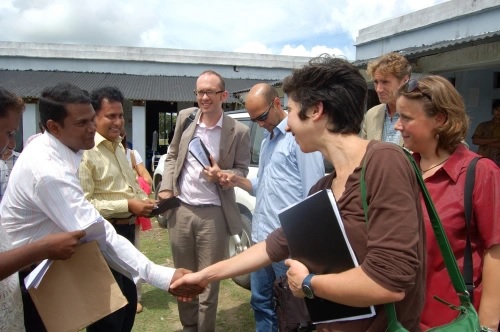
Sustainability
Community development initiatives must consider results for the present time and future. Sustainable development meets the needs of the present without compromising the ability of future generations to meet their own needs (International Institute for Sustainable Development). As Roseland (2012) suggests, sustainable development requires a fundamental economic and social change to improve human well-being while protecting the environment. Therefore, community development should produce self-reliant, self-sustaining communities that mobilize resources for the benefit of all members (Parada et al., 2012). Community work must not compromise any environmental and socio-economic degradation; instead, it works with the community with a holistic plan and actions for the community members’ well–being.
Respect Indigenous worldviews and local culture
Indigenous communities see development holistically. According to Cull (2018), Indigenous worldviews see the whole person (physical, emotional, spiritual, and intellectual) as interconnected to land and in relationship to others (family, communities, nations). Therefore, these holistic values should be adopted for socio-economic well-being and sustainable development in the community work practice. On the other hand, each community has a rich culture and heritage. Our community development work should respect local culture, norms, and practices. However, some community work may address harmful cultural norms and practices for fair living.
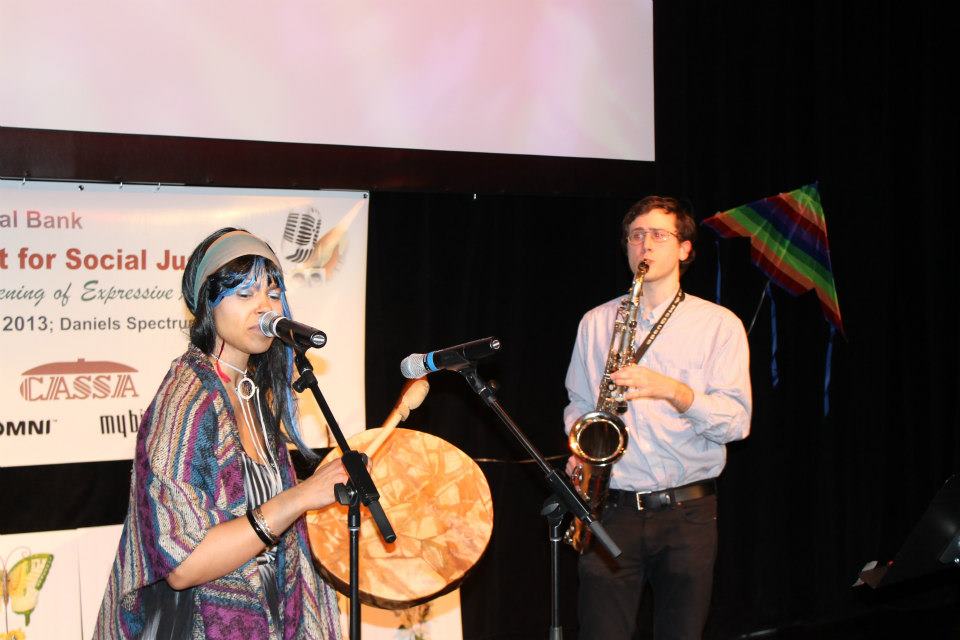
Resilience and empowerment
Finally, the ultimate goal of community work is to make the community resilient and empowered so that community people should be able to control and use their assets and means to influence. The community development practice should promote self-determination so that people and communities have the right to make their own choices and decisions (Scottish Community Development Center[SCDC], para#3). Community development initiatives should promote active citizen participation so that community members can meaningfully influence decisions that affect their situation (Michigan State University). In other words, the community development should strengthen people’s voices and allow them to take collective actions for their socio-economic, cultural, and environmental development and well-being.
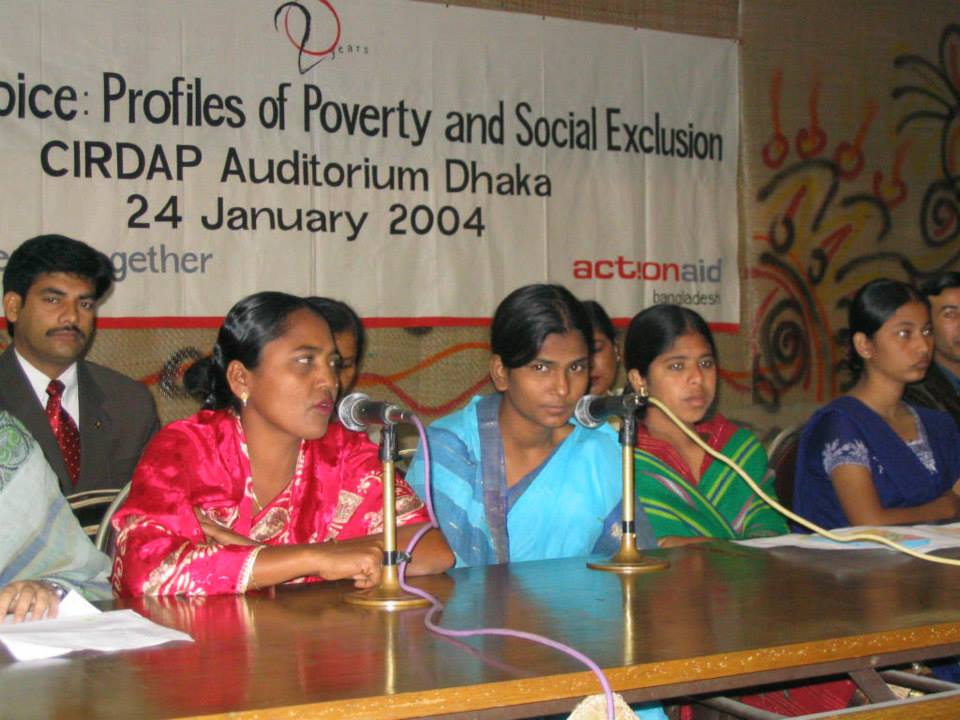
This resource book will expand the further discussion on how to utilize these principles in the community development practice in various chapters of this book.
Listen to a Podcast:
Community Development: Reflections on Principles, Process and Importance in Social Work.
Source: Podcasting Social Work
In this episode, Ma Pia Catherine, a student of Centennial College, shared her knowledge and experience in Community Development that she has received from Social Service Worker program. Dr. Hasan hosted this episode. For feedback or joining in a podcast episode, email at mhasan@centennialcollege.ca.
2. Process in Community Development
Community development is a highly process-oriented work. According to Brown and Hannis, “Effective community work is a process of engagement at a local level”(2012, p.71). The authors argues that the roles of the community worker vary significantly, depending on the community, employer/agency, and personal style.
The authors identified 10 steps where a Community worker may be involve. I am going describe each step based on Brown and Hannis (2012) and from my practical experience:
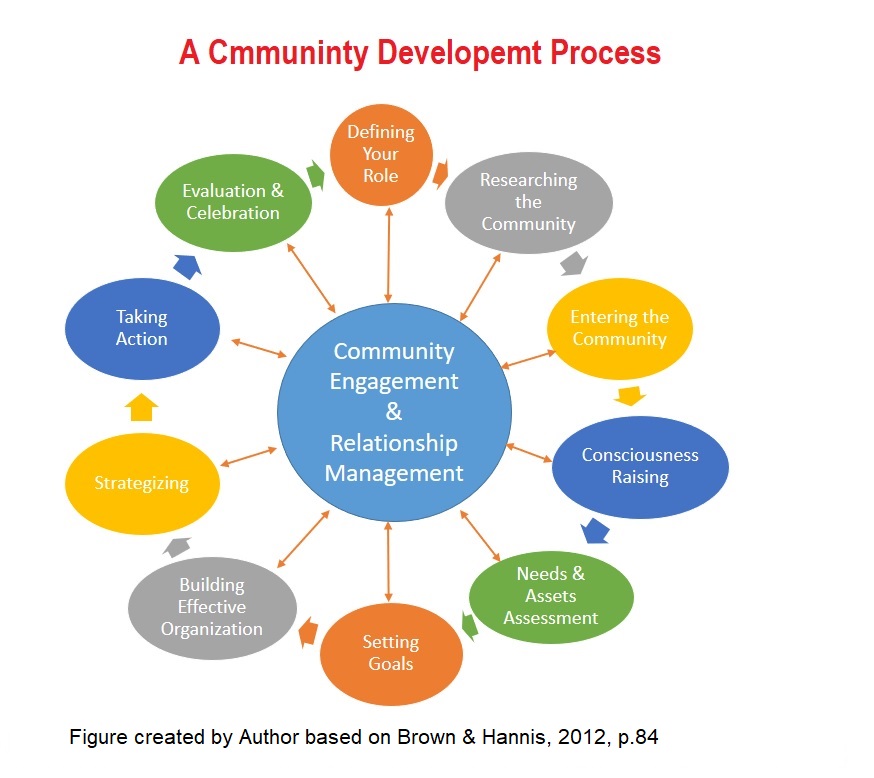
Step 1: Defining the professional’s role
Community worker may act as organizer, educator, coach, facilitator, advocate, negotiator, manager, researcher, and communicator (Brown & Hannis, 2012)
Step 2: Researching the Community
Community worker should learn the community by gathering information from secondary (statistics, Government and non-government agencies report etc.) and primary sources (interacting with community).
Step 3: Entering the Community
This step Is important because community worker needs understand the community dynamics, their history, culture, social capitals, power relations, and gradually approach community. Sometimes, community worker need formal approval to work with a community. For example, I had to take formal permission from Village Head while entering into an Indigenous community.
Step 4: Consciousness-raising
At the initial phase, community workers engage with local residents and discuss socio-economic issues by asking questions. In this step, community worker may utilize adult education for encouraging dialogue and learning. This process build sense of belonging among the community members, help them to understand and challenge oppression (Brown & Hannis, 2012). For example, at ActionAid, we implemented REFLECT and adult learning and community mobilization program for consciousness-raising.
Step 5: Assessment of Needs and Assets
It is a process where community worker collect information public forums, through survey, interviews, focus group discussion. Needs refers to gap between what exist and what should be in a community and assets are resources that can bridge the gap (Brown & Hannis, 2012). This step help community to develop a plan. A few tasks can be done at this stage:
- Identify community/affected people. This group/people will be the focus of community work
- Identify community issues, capacities and needs by engaging local community, agencies/institutions working/affiliated with the community.
- Identify stakeholders for the community project/initiative. Stakeholder means people or agency who are directly or indirectly related to the issue which may include local agencies, leaders, funders.
Step 6: Setting Goals
A goal is a short statement about “what a group wants to accomplish and should be based on reality” and example might be “ to form a neighbourhood youth council” (Brown & Hannis, 2012, p.84). A community worker can facilitate this process through a brainstorming session with community members and agency staff working locally.
Step 7: Organization Building
Community development work can be initiated by a group community people. It is helpful to establish an organization so that community and agency can raise funds. Most funders provide funding to non-profit and registered charities.
Step 8: Strategizing
A community worker can support agency to develop agencies strategic plan with vision, mission, objectives that reflects community proprieties.
- Objectives are statements of what to accomplish by when and they are concrete and action oriented ” (Brown & Hannis, 2012, p.86). Here is an example SMART objective: For a youth initiative may be “to increase the employment rate for youth in Regent Park by 10 % over three years” (Brown & Hannis, 2012, p.84).
- Strategies describe “how the objectives will be accomplished” (Brown & Hannis, 2012, p.84).
- The action steps explain who will do what by when.
- Select appropriate resource mobilization strategy.
- Identify local in-kind and cash resources to link with other resources to implement a specific plan with the community.
Step 9: Taking Action
Taking action is the critical step in community work. The community imitative may face challenges and resistance from community. Some work can be done at this stage are:
- Implement the strategy/plan emphasizing on shared leadership and collaboration.
- Engage the community in the implementation and monitoring of the project/ initiative
- Gather ongoing feedback on the interventions from the community
Step 10: Evaluation
At this stage, following work can be done:
- Assess the program impacts on the target audience and others to determine if the stated goals and objectives are met.
- Community members and program participants are consulted using research methods such as interviews, focus group discussion, case study collection
- Celebrate project success and share lessons learned
- If not successful, engage with community to replan and implement revised planVideo:
Video: YouTube, https://youtu.be/pNzNjAvqP_o
3. Case Study Analysis
Susan and the Seeds of Hope: Once a Casual Labourer, Now a Supplier at the Local Market
ActionAid Kenya published this story.
Communities living in arid and semi-arid areas in Kenya have traditionally relied on pastoralism for their livelihood but diminishing pasture land and protracted drought attributed to climate change has in the recent years affected the communities’ wealth and food security. In these communities, the men are the custodians of family land and livestock.
In Kambi Sheik, a remote village in Isiolo County, the story for many families is changing. As recurrent drought wreaks havoc in the area wiping out their few remaining animals, women are taking center stage to ensure their families are resilient to the effects of climate change and are food secure. Please click here to review it and identify the community development principles in this story.
Questions for Critical Reflections
i) What principles of Community Development did ActionAid use in engaging with Susan and her community in Kenya? Please give concrete examples that link to each principle.
ii) What assets are in your community? Give an example of a physical asset, a social asset, and an economic asset.
Key Takeaways and Feedback
We want to learn your key takeaways and feedback on this chapter.
Your participation is highly appreciated. It will help us to enhance the quality of Community Development Practice and connect with you to offer support. To write your feedback, please click on Your Feedback Matters.
Thank you!
References
Brown, J., & Hannis D. (2012). Community Development in Canada (2nd ed.). Toronto, CA: Pearson
Isiolo, T. (2019). Susan and the seeds of hope: Once a casual labourer, now a supplier at the local market. ActionAid Kenya. Retrieved on June 25, 2022 from https://kenya.actionaid.org/stories/2019/susan-and-seeds-hope-once-casual-labourer-now-supplier-local-market
Michigan State University, (n.d.). Principles of Community Development- Center for Community Economic Development. Retrieved June 23, 2022, from https://ced.msu.edu/about-cced/principles-of-community-development
Parada, H., Barnoff, L, Moffatt, K., & Homan, M. S. (2012). Promoting community change: Making it happen in the real world. (2nd Canadian ed.). Toronto: Nelson Education Ltd
Roseland, M. (2012). Toward Sustainable Communities (4th ed.). Canada. New Society Publisher.
Scotish Community Development Center, (n.d). What is community development? Retrieved June 23, 2022, from https://www.scdc.org.uk/who/what-is-community-development
Smart, J. (2017). What is community development? Australian Institute of Family Studies, CFCA Resource Sheet, January 2017. Retrieved June23, 2022 from https://aifs.gov.au/cfca/expert-panel-project/what-community-development

